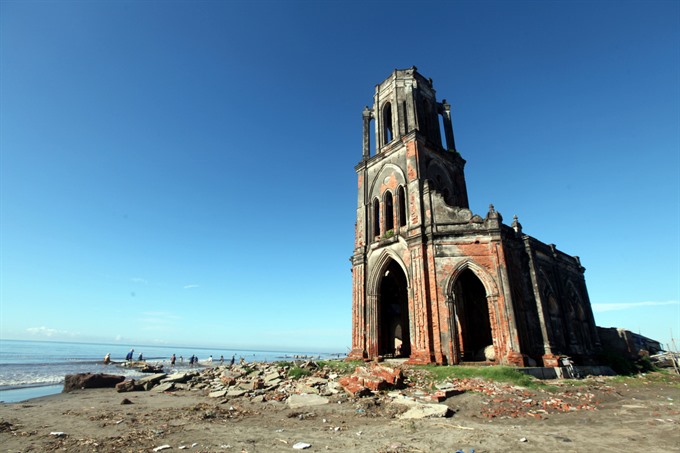 |
| Spooky: The ruined Hai Ly Church, a tourist hub in the locality. VNS Photo Tran Mai Huong |
Viet Nam News
by Tran Mai Huong
Our first glimpse of Hai Hau District in the northern province of Nam Dinh was roadsides full of flowers. In recent years, the land along the inter-village roads in the coastal district has been planted with flowers—indicating that people have not only focused on surviving by building, fishing and raising rice, but also on beautifying their community.
The total length of flower-filled roadsides in the district has reached more than 200km linking the communes of Hai Quang, Hai loc, Hai Dong, Hai Bac and Hai Van.
The idea was first launched by the Hai Hau Women’s Union.
“We have planted flowers along 19km of roads in our commune,” said Tran Thi Hoa, a local in Hai Quang Commune. “We are proud of that and love our land more.”
Nguyen Thi Tai, another woman in Hai Quang Commune, said that since the flower planting movement was launched, she has enjoyed caring for flowers along the road in front of her house.
Over the time, generations have built Hai Hau into a fertile, wealthy and beautiful region and made contributions to the process of building and protecting the country.
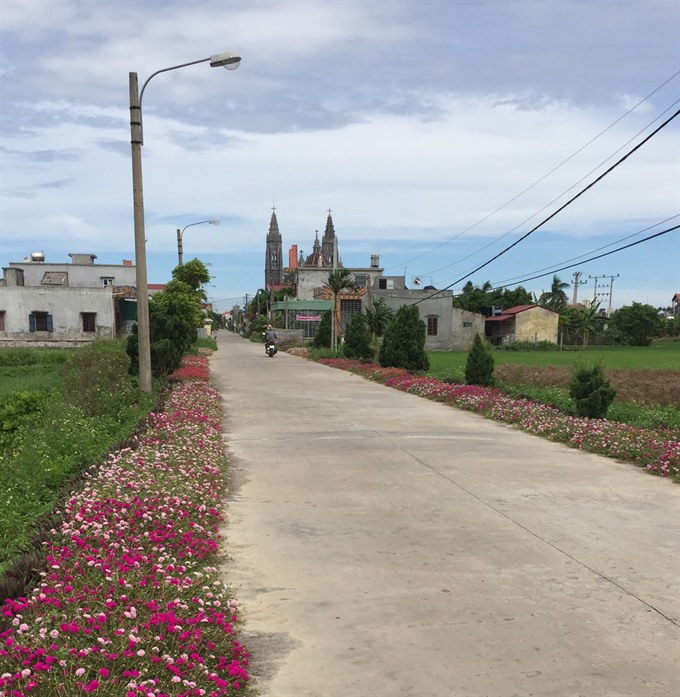 |
| Beautiful: Inter-village roads in the district are decorated with colourful flowers. VNS Photo Tran Mai Huong |
The district has a long and proud history. It was awarded the titles Army Force’s Hero in the war against the Americans and Hero in the Renewal Period. It was among the earliest districts in the region to reach the socio-economic standards of a "new rural area".
In 2016, the district notched economic growth of 8 per cent with an average annual income of nearly VND35 million (US$1,500) per head.
The flowery road, a thing of beauty created by people today, leads to a cultural historic site built by their ancestors hundreds of years ago.
The roofed bridge was built under the Le reign in the 16th century.
Together with the Pagoda Bridge in Hoi An and the Thanh Toan roofed bridge in Hue, the roofed bridge by the Luong Pagoda is one of three bridges of this kind in the country.
The bridge in Hai Hau District consists of nine compartments made of iron wood loaded on two big stone pillars. The bridge was carved with delicate decorative details while its structure is gently curved like an ascending dragon.
The roofed bridge and Luong Pagoda were part of the Quan Anh region in ancient times.
Quan Anh was the original heart of the Hai Hau District. Five centuries ago, ancestors of the Tran, Vu, Hoang and Pham families were among the earliest people to explore the coastal land. Then nine other families flocked to the area to settle down in the land stretching towards the sea.
I used to visit the district in the hard days before the renewal process kicked off in 1986. That’s why I can appreciate the significant changes that have taken place in the more than three decades since.
Many buildings have risen along the big roads linking communes in the district. Fertile fields have produced wealthy villages.
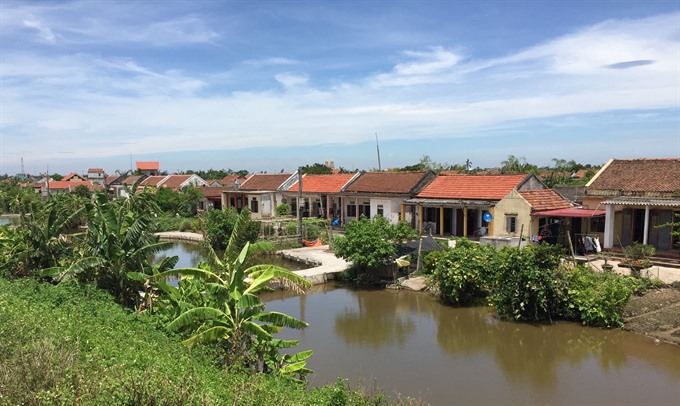 |
| Prosperous: A wealthy village in Hai Hau District in Nam Dinh Province. VNS Photo Tran Mai Huong |
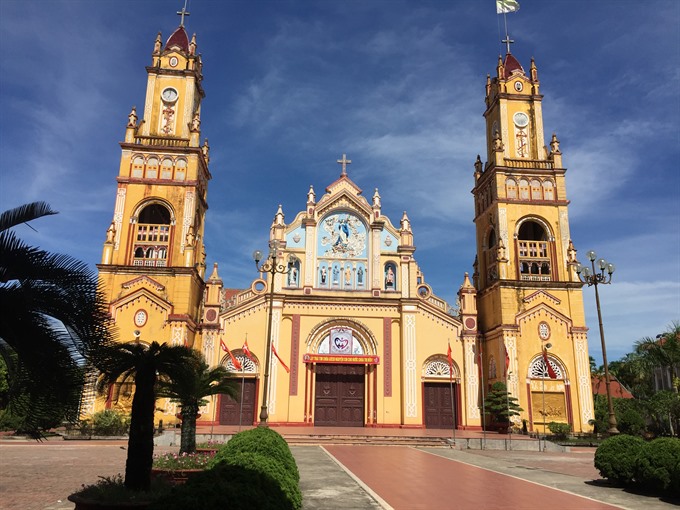 |
| Historic: A photo of Quan Phuong Church. VNS Photo Tran Mai Huong |
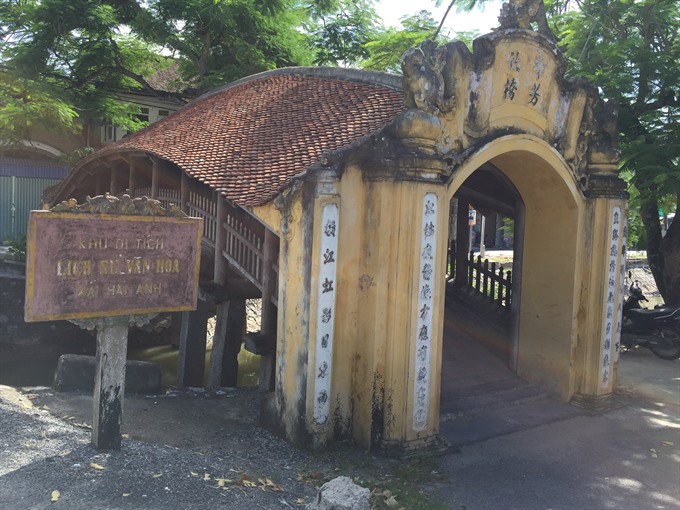 |
| Rare: A roofed bridge in Hai Hau which was built in the 16th century. VNS Photo Tran Mai Huong |
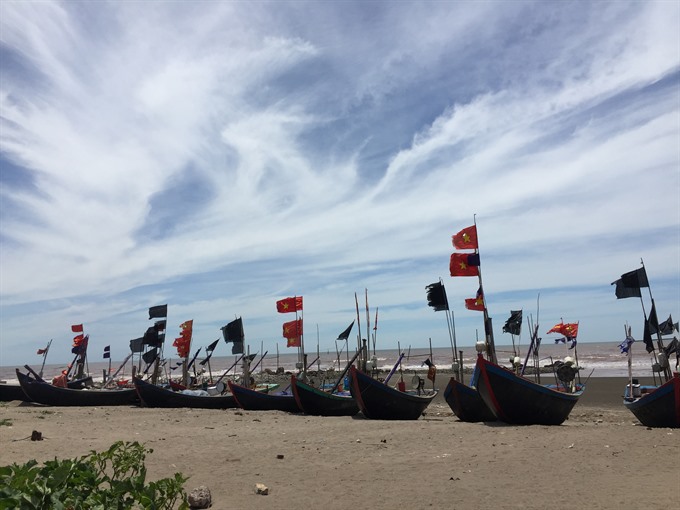 |
| Out to sea: A ship yard in the district. VNS Photo Tran Mai Huong |
Yen Dinh Town is now looking smart with new tall buildings. The Quan Phuong parish church still carries ancient beauty. The Van Ly salt fields and Con Market are popular places. Thinh Long resort area with small hotels and quiet bungalows for rent by the sea has become a popular destination for tourists from Ha Noi and other localities.
We stopped our car not very far from the Roofed Bridge and Luong Pagoda, two famed cultural relics in the district. The road to the site is decorated with beautiful flowers on both sides. Along the cement road running by the river, bright colourful moss roses are in full bloom under the sun. It’s a peaceful morning scene in a beautiful rural area.
A significant feature of Hai Hau is churches by the sea. Churches with diverse architectures stand in harmony with surrounding villages and pagodas.
Xuong Dien Church is a popular church with the architecture of a pagoda with tiled roof and wooden frame. The church is known as one of the 10 most beautiful churches in Nam Dinh.
The blend of European and Asian styles in the construction makes locals proud, as evidence for the skilful hands of Vietnamese workers.
The local community, however, wants a bigger church. Hence the ancient architecture may be rebuilt in near future.
The ruins of Hai Ly Church are another popular tourism spot in the area. Built in 1945, the church has been deserted as the sea approached the land. Because of this, the church has a special beauty right by the sea, and has become a popular site for wedding photo shoots.
There are 200 churches in Hai Hau District, which have attracted special care from local authorities and community members.
The district’s authorities have planned to preserve the ruins of Hai Ly Church as evidence of rising sea levels and the effects of climate change in the region to enhance locals’ awareness of the need to protect the living environment. — VNS
OVietnam